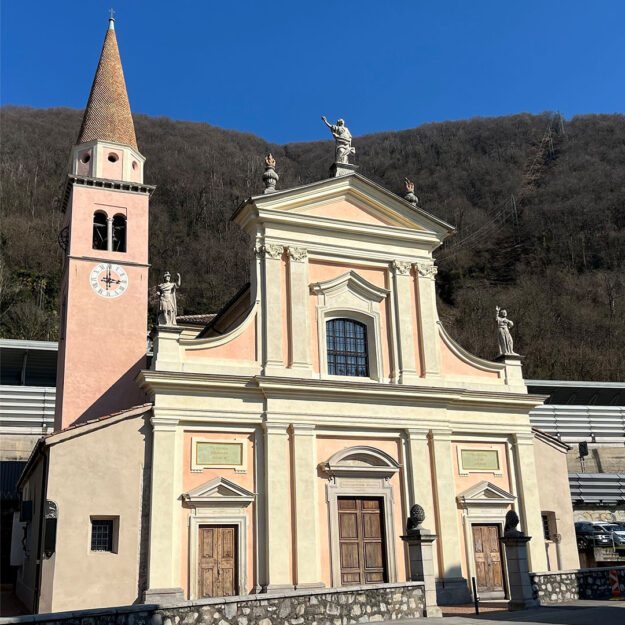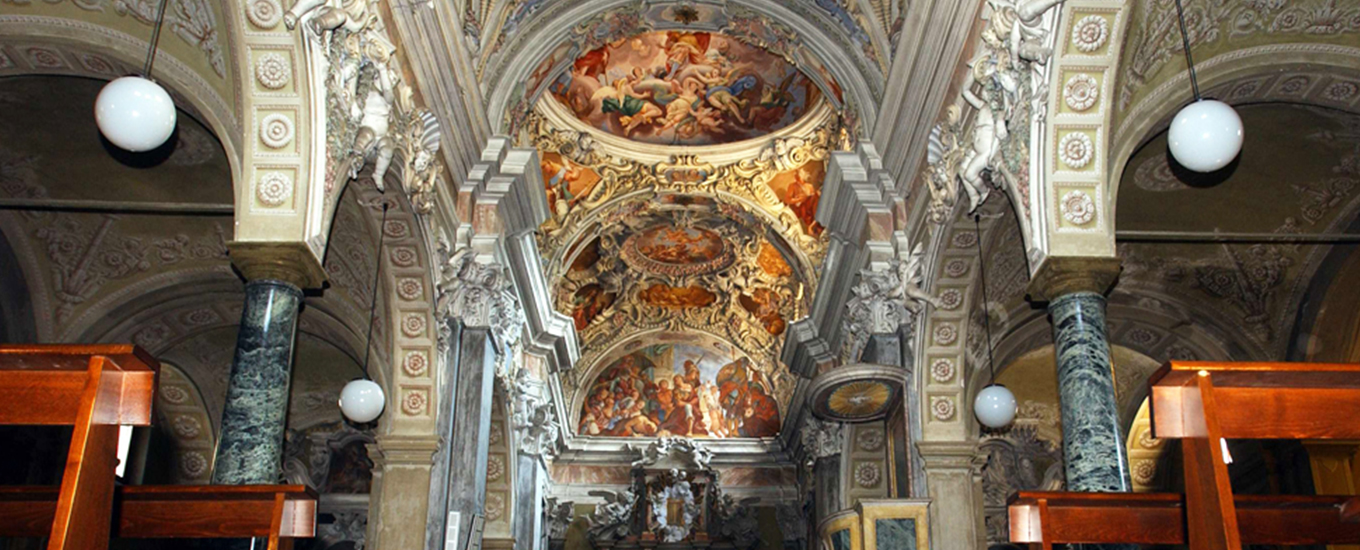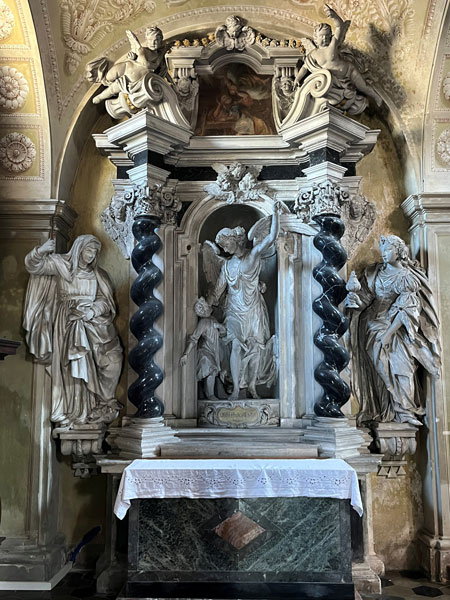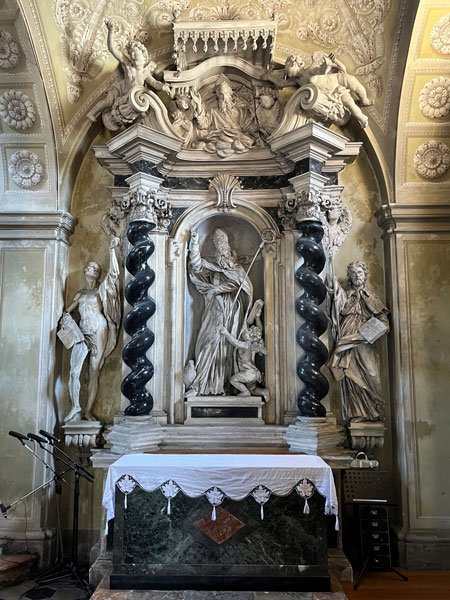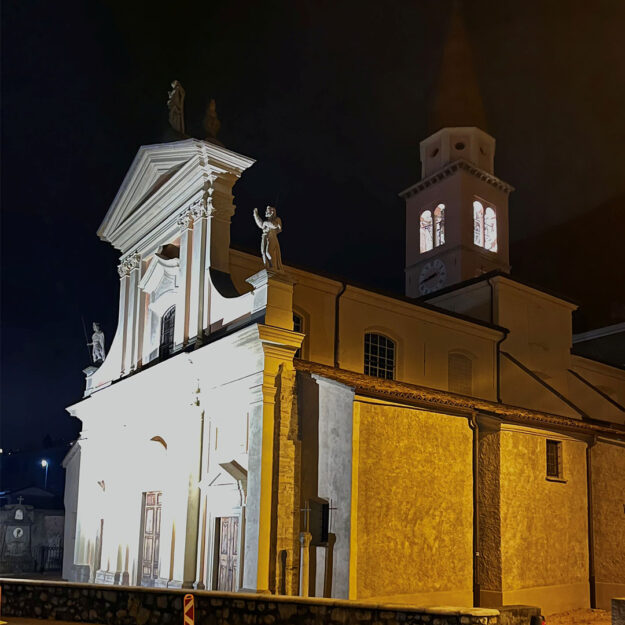1. Church of San Carpoforo
Located at the southern exit of the village, the parish church of San Carpoforo appears isolated from the ancient and compact urban centre of Bissone. The building, oriented on an east-west axis, faces the lake and the road, which already passed by the church in the medieval period.
The history
The history
The first mention of St. Carpoforo appears in a document dating back 1148, when the territories of Bissone belonged to the Milanese convent of Sant’Ambrogio. Its origins, however, can be traced back in the Lombard period of the 8th century a.C. In the medieval times there was a castle near the church, which was destroyed but still documented at the end of the fifteenth century.
While the structure and appearance of the building in the medieval period remains unknown due to the lack of documentary sources, it is possible to reconstruct its history from the last quarter of the sixteenth century onwards. The sixteenth-century building already had a basilica plan with three naves, with a rectangular choir.
During the last years of the 16th century and in the first half of the following century, the side altars were replaced by chapels that were inserted into the two side aisles, adding to the chapel of the baptismal font.

Baptistery - Baptismal font
During the last quarter of the 17th century, the building underwent extensive renovation, giving rise to the church that can be seen today, with the exception of the facade, which was erected after 1730.
The basilica shape of San Carpoforo is clearly visible from the outside with the central nave significantly higher than the two side aisles which are connected to the chapels by a single roof. On the northern side of the choir stands the massive bell tower with a neo-Romanesque profile and is characterised by the octagonal drum topped by a conical roof with a scale-like covering.
The façade shows a strong classical influence, especially in the precise, geometric and almost austere composition of the various parts and in the choice of classical decorative elements of the Lombard architecture in the 17th and 18th centuries.
Inside, the naves are divided into four bays, marked by marble columns and pillars with composite capitals.
The central nave is marked by round arches above which a cornice separates the barrel vault with lunettes and then the lowered ovoid dome, creating a rhythm that enlarges the space of the nave upwards before closing in the choir area.
It is above all for the stucco decoration that San Carpoforo represents a very valid example of regional monumental architecture.
The painted field in the centre of the vault of the choir presents a vision of Paradise with numerous putti and winged heads, while the eight mixtilinear surrounding plaques are interspersed with representations of the four evangelists and the cardinal virtues.
Renovated in the last quarter of the 17th century, the altar has a decorated structure made by various types of marble. The three niches contain terracotta statues of the Virgin with children, St. Carpoforo (on the right) and St. Peter (on the left), works from the mid-sixteenth century attributed to Tommaso Lombardi of Lugano.
In the regional monumental panorama of the late Baroque period, San Carpoforo occupies a position of primary importance, but it is for the stucco decoration that the Bissone church has earned a place in the history of this artistic technique, transcending regional borders.
Despite their Baroque character in terms of plasticity and form, the stuccoes of San Carpoforo can be linked to new and innovative Nordic influences, which take the form of a new concept of exuberant and festive decorative ensembles, where the joy of light, colours, contrasts and inspiration from nature give life to a true blossoming of stucco, anticipating the taste of several decades.
SAINT CARPOFORO
The name day is traditionally celebrated on August 7 in memory of Saint Carpoforo, martyred in Como with other companions of the same faith. The Church also commemorates other saints with the same name: a martyr with St. Rufo in Capua, on August 27; another in Rome with the brothers Severiano, Sevaro and Vittorino, known as the Four Crowned Martyrs (Quattro Coronati), on November 8; and a priest, martyred with the deacon Abbondio, on December 10.
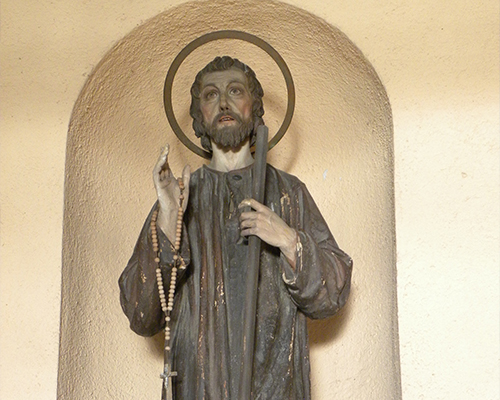
Historical notes on the parish of Bissone which became independent in 1474.
In the beginning, the activity of the priests who founded the parish churches must have been quite difficult. They did not have a stable home and lived off the alms of the population. As the parish became more established, their work became more incisive.
Over time, the parish churches became organized. Parish priests settled there permanently, and their sustenance was ensured by the population or by the assets of the parish. The parish priest (archpriest) was responsible, by delegation of the bishop, for the care of souls, the administration of the sacraments, the celebration of baptisms and marriages, all within a fairly large territory.
The availability of other priests to bring the word of God to the valleys and to the most remote locations slowly led to the creation of chapels, always dependent on the parish church. But as time passed and with the ever-increasing attendance of the faithful, their importance grew to the point that they separated from the plebeian matrix.
Thus, the first autonomous parishes were born, in which the presence of a parish priest was guaranteed by the income from assets attributed to the church and by contributions from the population. It was a long journey, lasting several centuries, during which new churches were built, existing ones were enlarged and embellished, chapels were built, thud creating an artistic heritage of inestimable cultural value.



